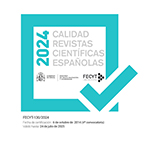"Guía del perfecto latino" (1848) by Luis de Mata i Araujo, or the defeat of Humanism in Spain
Abstract
This paper will show how the posthumous work of Luis de Mata i Araujo, his Guía del perfecto latino (1848), was written in order to provide an alternative viewpoint to the Manual histórico-crítico de la literatura latina, written by Ángel María Terradillos in 1846. Both scholars –the former, the Chair of Latin language in the Universidad Central; the latter, a lecturer in this same university– represent two different ways of understanding the emerging teaching of Latin literature. Mata i Araujo follows the patterns established during the Spanish Enlightenment, whereas Terradillos abides by the new liberal education, led byAntonio Gil de Zárate. This kind of education preferred providing the new citizens with a thin veneer of classical culture, rather than a deep knowledge of Latin. This divorce between the teaching of a classical literature and the language itself probably stands for the final defeat of Humanism in contemporary Spain.
Downloads
Article download
License
In order to support the global exchange of knowledge, the journal Cuadernos de Filología Clásica. Estudios latinos is allowing unrestricted access to its content as from its publication in this electronic edition, and as such it is an open-access journal. The originals published in this journal are the property of the Complutense University of Madrid and any reproduction thereof in full or in part must cite the source. All content is distributed under a Creative Commons Attribution 4.0 use and distribution licence (CC BY 4.0). This circumstance must be expressly stated in these terms where necessary. You can view the summary and the complete legal text of the licence.








